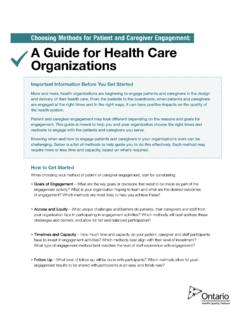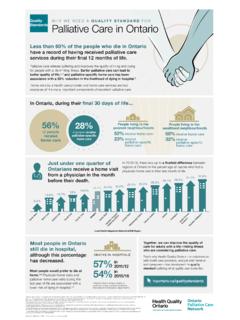Transcription of Measurement Guide. Palliative Care - hqontario.ca
1 Quality Standards Palliative Care Measurement Guide April 2018 Palliative Care Measurement Guide Page 2 Contents 1 How to Use the Measurement Guide .. 3 2 Quality Indicators in Quality Standards .. 4 Measurement Principles .. 4 Process Indicators .. 4 Structural Indicators .. 5 Outcome Indicators .. 5 3 Local Measurement .. 6 Local Data Collection .. 6 Measurement Principles for Local Data Collection .. 6 Benchmarks and Targets .. 7 4 Provincial 9 Accessing Provincially Measurable Data .. 9 5 How Success Can Be Measured for This Quality Standard .. 10 Quality Standard Scope .. 11 Cohort Identification .. 11 How Success Can Be Measured Provincially .. 12 6 Resources and Questions .. 19 Resources .. 19 Questions? .. 19 7 Appendix: Data Sources Referenced in This Quality Standard .. 20 Palliative Care Measurement Guide Page 3 1 How to Use the Measurement Guide This document is meant to serve as a Measurement guide to support the adoption of the quality standard Palliative Care.
2 Care for adults living with a progressive, life-limiting illness is a critical issue, and there are significant gaps and variations in the quality of care that people receive in Ontario. Recognizing this, Health Quality Ontario released this quality standard to identify opportunities that have a high potential for quality improvement. This guide is intended for use by those looking to adopt the quality standard Palliative Care, including health care professionals working in regional or local roles. This guide has dedicated sections for each of the two types of Measurement within the quality standard: Local Measurement : what you can do to assess the quality of care that you provide locally Provincial Measurement : how we can measure the success of the quality standard on a provincial level Important Resources for Quality Standard Adoption Health Quality Ontario has created resources to assist with the adoption of quality standards: A Getting Started Guide that outlines a process for using quality standards as a resource to deliver high-quality care.
3 It includes links to templates, tools, and stories and advice from health care professionals, patients, and caregivers. You can use this guide to learn about evidence-based approaches to implementing changes to practice A Quality Improvement Guide to give health care teams and organizations in Ontario easy access to well-established quality improvement tools. The guide provides examples of how to adapt and apply these tools to our Ontario health care environments An online community called Quorum that is dedicated to working together to improve the quality of health care across Ontario. Quorum can support your quality improvement efforts Palliative Care Measurement Guide Page 4 2 Quality Indicators in Quality Standards Quality standards inform providers and patients about what high-quality health care looks like for aspects of care that have been deemed a priority for quality improvement in the province.
4 They are intended to guide quality improvement, monitoring, and evaluation. Measurability is a key principle in developing and describing the quality statements; each statement is accompanied by one or more indicators. This section describes the Measurement principles behind the quality indicators, the process for developing these indicators, and the technical definitions of the indicators. An effective quality statement must be measurable. Measurement is necessary to demonstrate if a quality statement has been properly implemented, and if it is improving care for patients. This is a key part of the Plan-Do-Study-Act improvement cycle. If Measurement shows there has been no improvement, you need to consider a change or try something different. Measurement Principles Health Quality Ontario uses the process, structure, and outcome indicator framework developed by Donabedian in 1966 to develop indicators for quality standards.
5 The three indicator types play essential and interrelated roles in measuring the quality of health care and the impact of introducing and using quality standards. The indicators provided are merely suggestions. It is not expected that every provider, team, or organization will be able measure all of them (or even want to measure all of them), but they can identify which indicators best capture areas of improvement for their care and what is easiest to measure given existing local data sources. Process Indicators Process indicators assess the activities involved in providing care. They measure the percentage of specified individuals, episodes, or encounters for which an activity (process) is performed. In most cases, the numerator should specify a time frame in which the action is to be performed, established through evidence or expert consensus. When a quality statement applies to a subset of individuals rather than the total population, the denominator should reflect the population of the appropriate subgroup, rather than the entire Ontario population.
6 If exclusions are required or stratifications are suggested, they are reflected in the indicator specifications. Process indicators are central to assessing whether or not the quality statement has been followed; nearly all quality statements are associated with one or more process indicators. In most cases, the numerator and denominator for process indicators can be derived from the language of the quality statement itself; additional parameters (such as a time frame) may also appear in the definitions section. In some cases, a proxy indicator is provided that indirectly measures the process. Proxy indicators are used only when the actual indicator cannot be measured using currently available data. While most quality statements focus on a single concept and are linked with a single process indicator, some statements include two or more closely related concepts. In these cases, multiple process indicators can be considered to capture all aspects of the quality statement.
7 Palliative Care Measurement Guide Page 5 For example, a quality statement might suggest the need for a comprehensive assessment with several components, and each of those components might have a process indicator. Examples of process indicators include the percentage of patients with hip fracture who receive surgery within 48 hours, or the percentage of patients with schizophrenia who are offered clozapine after first- and second-line antipsychotics have been ineffective. Please refer to the published quality standards for more examples. Structural Indicators Structural indicators assess the characteristics and resources that influence and enable delivery of care. These can include equipment; systems of care; availability of resources; and teams, programs, policies, protocols, licences, or certifications. Structural indicators assess whether factors that are in place are known help in achieving the quality statement.
8 Some quality statements have structural indicators associated with them. Structural indicators are binary or categorical and do not require the definition of a numerator and denominator. However, in some cases it could be useful to specify a denominator defining an organizational unit, such as a hospital, a primary care practice, or a local region. In many cases data for structural indicators are not readily available using existing administrative data, so local data collection might be required. This local data collection might require regional or provincial-level data-collection systems to be developed. Structural indicators should be defined for a quality statement or for the quality standard as a whole when there is strong evidence that a particular resource, capacity, or characteristic is important for enabling the effective delivery of a process of care. It should be theoretically feasible for these structural elements to be implemented across Ontario, even if adoption is aspirational in some cases.
9 In rare instances, a quality statement may have two or more associated structural indicators, if the quality standard advisory committee decides that multiple factors are crucial to the delivery of the quality statement. Examples of structural indicators include the availability of a stroke unit, the existence of discharge planning protocols, or access to a specialized behavioural support team. Please refer to the published quality standards for more examples. Outcome Indicators Outcome indicators assess the end results of the care provided. They are crucial and are arguably the most meaningful measures to collect, but many health outcomes such as mortality or unplanned hospital readmissions are often the product of a variety of related factors and cannot be reliably attributed to a single process of care. For this reason, although relatively few quality statements are directly linked to an outcome indicator, a set of overall measures including key outcome indicators is defined for the quality standard as a whole, reflecting the combined effect of all of the quality statements in the standard.
10 Similar to process indicators, outcome indicators should be specified using a defined denominator and a numerator that, in most cases, should include a clear time frame. Examples of outcome indicators include mortality rates, improvement (or decline) in function, and patients experience of care. Please refer to the published quality standards for more examples. Palliative Care Measurement Guide Page 6 3 Local Measurement As part of the quality standard Palliative Care, specific measures were identified for each of the statements to support Measurement for quality improvement. As an early step in your project, we suggest that your team complete an initial assessment of the relevant measures in the standard and come up with a draft Measurement plan. Here are some concrete next steps: 1. Review the list of identified measures (in the quality standard), and determine which measures you will use as part of your adoption planning, given your knowledge of current gaps in care 2.









